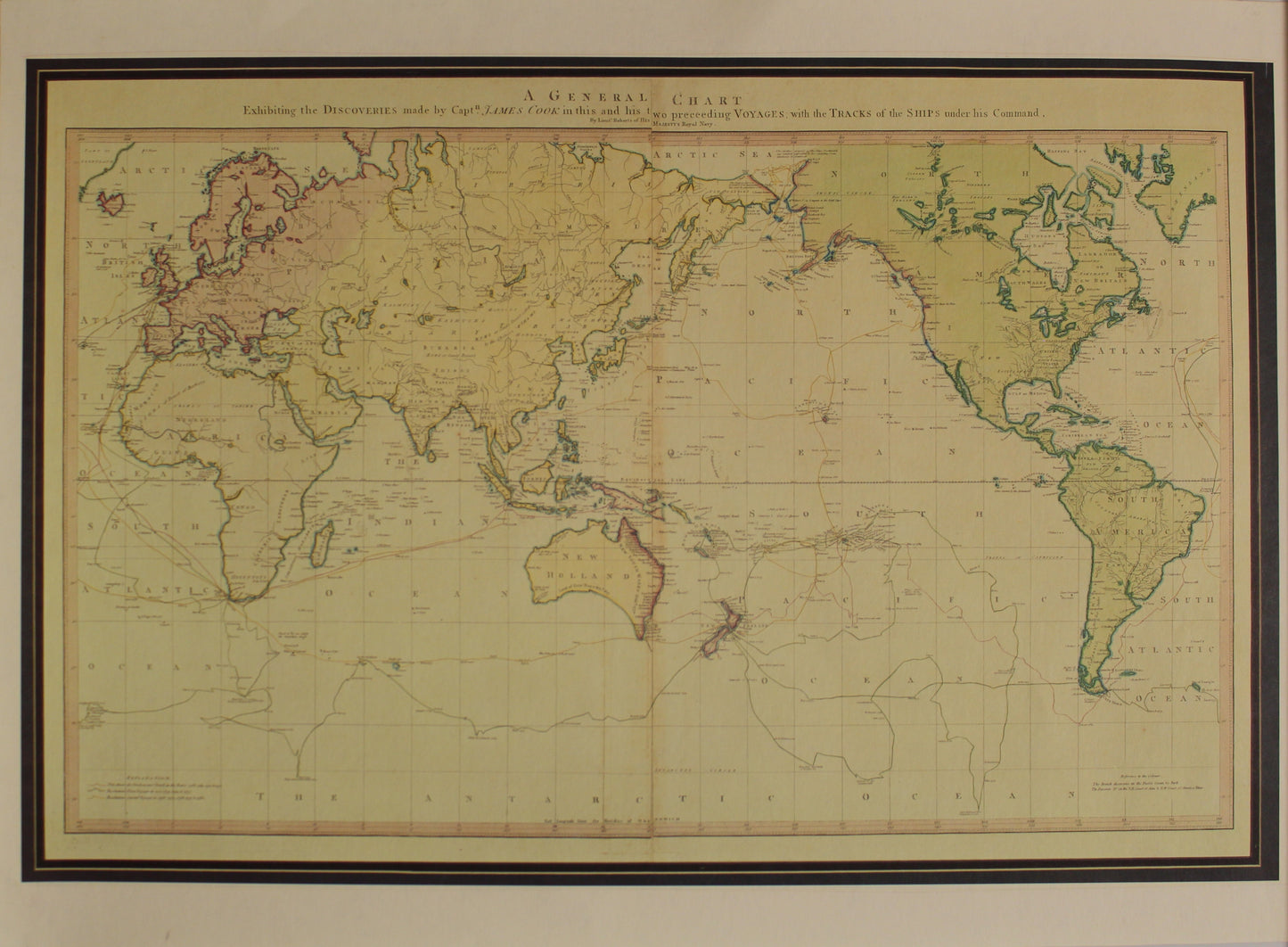Antiquarian Print Shop
Map, The World, General Chart, Lieut Roberts, Reproduction
Map, The World, General Chart, Lieut Roberts, Reproduction
Couldn't load pickup availability
Date: 1784
Artist: Roberts, Lt Henry
Engraver: not known
Paper size: 475 x 660mm
Condition: Good
Reproduction printed in colour
Technique: Copperplate engraving (the original)
Price: 70.00
Fine full original wash color example of Henry Roberts' scarce and highly detailed map of the World on Mercator's Projection, identifying the routes of Captain James Cook's voyages aboard the Endeavor (1768-1771) and Resolution (1772-1780) and Russian Explorations in the North Pacific.
Drawn by Lt. Henry Roberts, who accompanied Cook on his voyages, the map provides a detailed, large format account of Cook's 3 expeditions, including dates and the many places where Cook coasted and landed during his 12 years at Sea. The map includes several other early exploration notes, and provides a fantastic graphic depiction of Cook's explorations, prior to his untimely death in Hawaii at the hands of native Hawaiians.
The map identifies the areas touched on by Cook's expeditions in a brighter red wash, with the Russian discoveries along the Northwest Coast of America and Northeast Coast of Asia identified in a blue wash. Although not shown on Cook's Route, the area around Drake's Bay and Monterey are also colored in red, prior to the naming of San Francisco. This curious detail is of note, as the legend at the bottom right states that "British Discoveries in the Pacific &c." are marked in red (Russian discoveries in Blue), perhaps foreshadowing the anticipated intrigue between Russia and European nations over California and the Northwest Coast which would draw the attention of French and Spanish explorations until the 1840s, when control of the entire coastline south of Vancouver fell to the Americans.
The map is virtually identical in size and content to the official map prepared by Roberts for the official account of Cook's Third Voyage, A Voyage to the Pacific Ocean . . . , first published in London in 1784, with the exception of the annotations in the bottom right and left.
This general chart is one of two Roberts charts that were issued by Faden in 1784. Faden also published Henry Roberts's so-called "lost chart of Captain James Cook," which was prepared by Roberts following his service as the Master's Mate on the HMS Resolution. The chart was originally prepared for the atlas which accompanied the official account of Cook's third voyage ( A Voyage to the Pacific Ocean. . . , London: 1784 ), but because of disputes among the editors, it was not included in the final publication of the official account.
It is now known that the plate for the so-called "lost chart," "a version more elaborate than that in the authorized atlas", was purchased by Faden and published separately. This exceptionally rare first state of the Roberts - Faden chart, in addition to showing Cook's discoveries, was the first published map to show the discoveries of Samuel Hearn in the Canadian Arctic. Hearn's journal and maps were not published until 1795.
Cook's death left the production of the expedition's findings to two camps of editors: on the one hand were Henry Roberts and Captain King, (the authors of the charts and journals, respectively) and on the other hand was Alexander Dalrymple, Cook's longtime rival, and his political supporters. Dalrymple won out, and Roberts' chart was replaced with the less-detailed map engraved by T. Harmar, perhaps as a brief attempt at keeping some of Cook's discoveries secret from the competing Russian explorers in the region.
Roberts' "lost chart" contains a number of place names not found on the authorized version. The Roberts chart also includes important information, which had never previously appeared in print, showing the Coppermine River (information probably suppressed for commercial reasons by the Hudson's Bay Company) and the impossibility of a Northwest Passage through Hudson's Bay to the Pacific Ocean.
It was not understood that Roberts' chart and the Faden were the same until 1985 when the British Library acquired a proof state of the map. Roberts had sold his copperplate to Faden, who published the "lost chart" a month after the publication of the official atlas. Faden also employed the same color scheme on the "lost chart" to show the Russian and British discoveries but also adds in yellow wash color to illustrate the discoveries of the Spanish.
Share


